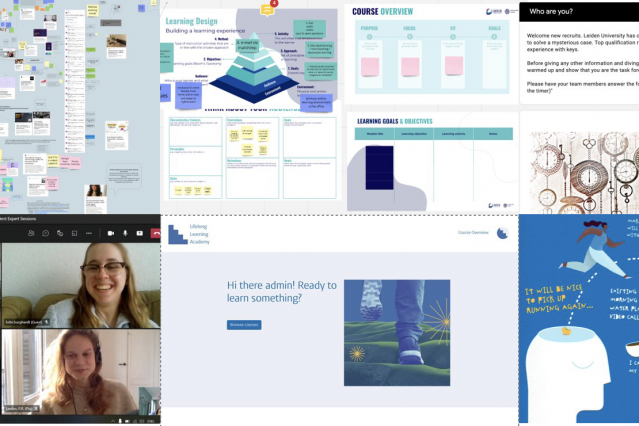Insights, Publications
Demystifying Innovation Methodology: Six principles for navigating innovation
Innovation is gaining increasing attention from organisations across sectors of all sizes. Innovation now appears in countless job titles, and some organisations even add a “Chief Innovation Officer” to their executive leadership. Higher Education is no different, and innovation has become a strategic priority for many universities, often at the highest level of governance. However, the additional attention and hyperactivity around the topic can easily suffocate the conditions for innovation.
The Centre for Innovation is Leiden University’s hub for the methodology and practice of innovation in higher education. Over the past eight years, we’ve worked with diverse internal and external stakeholders on various innovation projects and explored a wide range of innovation methodologies. In our line of work, there are common misconceptions about innovation that we repeatedly encounter. For example, there are different perspectives on whether innovation can be a goal in itself or whether or not innovation can be managed in the same way that a regular project can be managed.
With so many different and divergent perspectives on innovation, it can be difficult to get shared expectations about what role innovation should have in your university, faculty, or program. We present six principles that help demystify the innovation process, making it simpler and more practical, distilled from our experiences over the last eight years. Think of these principles as a compass while innovating, providing guidance and direction rather than a step-by-step playbook for how to do innovation.
1. Know the problem you’re trying to solve.
An unwritten law of innovation states that if you can define the problem clearly and simply, the matter is half solved. It’s easy to start innovation project initiatives because the general consensus is that things could be better, but innovation is not simply doing new things or trying to improve things. To be effective, innovation must be positioned within a context and a concrete problem. Innovation is a tool to turn problems into greater opportunities. However, without investigating and understanding the problem and the more general context which produces or sustains the problem, innovation has no boundaries and will, therefore, rarely be impactful.
Navigation tip: Before starting an innovation project or initiative, first analyse your starting point and frame it in terms of a concrete problem that needs to be addressed. For example, instead of saying, “we want to innovate the classroom,” start by asking, “what are the biggest issues users encounter in the classroom, and what are the effects of these limitations?” Then form hypotheses of how you can innovate solutions to those issues.
2. View the problem from the perspective of a system.
Innovation doesn’t happen in a vacuum, and it should therefore be understood within the broader organisational system. Similarly, problems don’t occur out of nowhere. They are created by a process in which different parts interact. For example, you might think the reason, so few teachers are using active learning classrooms is that there are too few rooms to meet demand, but it’s important to understand the system by which rooms are accessed, which involves course planning and even hiring/HR practices. Looking at the organisation as an ecosystem — a collection of pieces that are connected to and interact with one another — is the only way to fully understand where innovation can and should live. Taking this system view helps identify dependencies and where changes in one area would have effects in another.
Navigation Tip: When analysing your innovation agenda, create a problem workflow. This should take the form of a flowchart that expresses your understanding of how the system you’re trying to innovate in works. For example, having generated a problem definition for users of classrooms, ask, “what role does the classroom play in the broader function of teaching?” and “what role does teaching play in the broader careers of those people involved in it?” Only this way can you identify underlying and (at first glance) unrelated systemic issues that either help or hinder your goal to innovate on your problem definition.
3. Make innovation a capacity that can grow in the organisation, not a function of one role or department.
Innovation is a capability strategy, not a separate stream of work. Many large organisations have a department or centre responsible for innovation, just as we do at Leiden University. It’s crucial that innovation has some free space to breathe, and it shouldn’t be scattered loosely across the organisation. However, isolating innovation into either a single team or a single role within a team ultimately pushes innovation away from the important work that’s done at the heart of the organisation. To be truly effective, innovation needs to be treated as a capacity of which the whole organisation is capable. Like all capabilities, innovation skills take time to build.
Navigation tip: Make all innovation projects multi-stakeholder projects. Ensure that governance of innovation projects represents all the different stakeholders affected by the innovation. Set long-term goals around the organisation’s overall capacity to innovate, not just the output of your innovation team or functions.
4. Don’t believe in Unicorns.
It’s tempting to view innovation as a result of the intrinsic motivation of a couple of like-minded and utterly unique outsiders. This romantic notion may hinder the ability for innovation to flourish because it pushes innovation outside the normal channels of governance, reporting, funding and performance. Viewed this way, innovation will never reach the level of urgency required to sustain ongoing and meaningful impact. No amount of energy and enthusiasm can overcome misaligned governance, policy, finances, or culture. Innovation should be taken as seriously as your ordinary business, though it should be managed differently.
Navigation tip: Throughout your organisation, be transparent with stakeholders about your level of knowledge about innovation methodology and practice. Innovation can be successful even when knowledge of methods and practices is limited. However, faking urgency, experience, or skill in innovation sets inappropriate expectations, which might eventually lead to disappointing results.
5. Rethink the role of leadership.
Innovation can be steered, but it can’t be easily managed. True innovation involves a level of serendipity, chance, and speculation. For that reason, it can never be fully managed and replicated in the way many other processes can because managing innovation is all about making decisions on uncertain directions in the front-end of innovation. Their job is to make these directions less fuzzy and uncertain. Management and executives need support to function as steerers and to guide as facilitators, rather than traditional managers.
Navigation tip: Start a mentorship program for senior leadership to adopt and support innovation projects or initiatives. Contrary to sponsorship (where a senior leader accepts responsibility for a project at a high level), mentorship encourages a culture of innovation, openness, and exchange and increases the surface area of the organisation involved in innovation.
6. Failure is not as good as it sounds.
Nowadays, failure has a good name. It’s common to hear “fail fast to succeed faster” or that “if things aren’t failing, then you’re not innovating enough.” While it’s true that failure of an innovation can generate useful findings, if there are too many concurrent causes of failure or the failure is due to a part of the system you’re not aware of, then it’s more likely that a failure will repeat itself over and over again. If a project fails for ten different reasons, but you’re unaware of nine of them, your next innovation will likely fail too.
Navigation tip: Findings from an innovation failure need to be situated within your system perspective and problem definition. Every failure should have a clear and direct link to what you know about how to innovate effectively. Failure should falsify something you thought was true, either about the problem or the system the problem exists within.
Innovation is difficult to get right but very easy to get wrong. These six principles should be understood as a compass that can steer your organisation away from the biggest potholes. When structured, nurtured, and supported, innovation can grow into one of your organisation’s biggest strengths.







